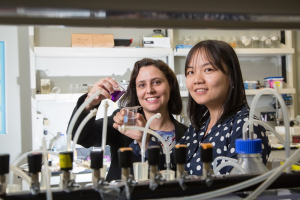The National Science Foundation (NSF) recently awarded $300,008 to two UH Cullen College of Engineering professors for their research into the development of coatings designed to play a role in water purification.
The award began in summer 2019 and will last three years for the project titled “Rates and Mechanisms of Biofouling and Mineral Scaling on Zwitterionic Amphiphilic Copolymer Surfaces.” The researchers, both associate professors of civil and environmental engineering, believe the project may take longer.
“What we’re trying to do is prevent any buildup of contaminants by coating a membrane with a special polymer,” explained Yandi Hu, who is the principal investigator for the research project at UH. “Our goal is to end up with pure water by rejecting all unwanted matter, like toxic metals, ions and biohazards.”
The study addresses two types of foulants or contaminants – chemical scales, which are the focus of Hu’s research, and biofouling, which is the specialty of the project’s co-principal investigator Debora Rodrigues.
The research has the potential to help ease the global water crisis by developing water filters so efficient they far surpass current options to make water safe to drink. Such better, smaller filters could help make it more practical to transport and operate water purification systems in rugged or impoverished regions of the world where clean drinking water is frequently absent.
Industries such as petroleum and shipping are likely to benefit too from new ways to prevent unwanted foulant formation. For example, improved pipe linings could help transport oil more efficiently and special coatings could make ship hulls easier to maintain – two of the possible outcomes likely to yield significant economic benefits.
Potential results could eventually affect many aspects of society and commerce. But for now, the two researchers stress, the project is still in early phases of discovery and much work remains to be done in the laboratory.
The UH research project operates independently but in coordination with a project at Tufts University. That research is led by Ayse Asatekin, a Tufts chemical and biological engineering associate professor, who is an expert on ZACs (zwitterionic amphiphilic copolymers). ZACs are compounds that show impressive qualities against organic contaminants.
Testing the waters
“We depend on the Tufts team to prepare the ZAC coatings on the membranes and other surfaces, which are sent to us here at UH. We then perform the investigation within a water-treatment process called the reverse osmosis (RO) system,” Rodrigues explained.
As their research shows new understanding of how ZACs affect mineral scaling and biofouling on the study membranes, Hu and Rodrigues will explore ways to adapt the components in search of the most suitable variation.
The ultimate benefit, they explained, would be to identify a single coating whose properties have excellent abilities against both biological and mineral foulants. But in the end, specific needs may call for multiple types of coatings to be developed.
As their research findings become clear, Hu and Rodrigues plan to share the new knowledge at national and international conferences that draw attendees from utility groups, corporations and consulting firms, as well as academic researchers. More immediately, the information will be included in several graduate and undergraduate classes at UH and beyond.
“It’s a lot of work. But still, it’s something we love to do. And if it’s fun, I don’t really consider it to be work,” Rodrigues said. “We see something positive that, hopefully, will bring something good to the society in the end.”
